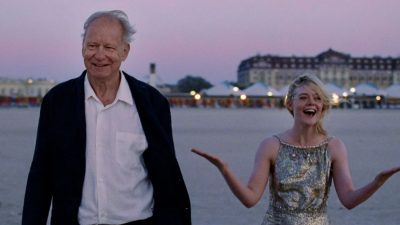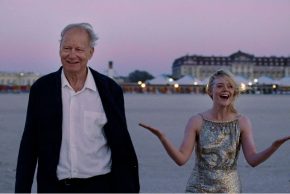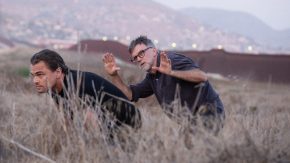Péter Eötvös is internationally well-known and acknowledged, and he’s even Artist of the Year at the Müpa (he will perform with the Hungarian National Philharmonics, and conduct his own pieces soon). He’s kind of a headliner whose name makes audience pay attention. There is another name, though, on the margin of his September concert: Ryoko Aoki as the “narrator”. It’s time for us to get to know this Japanese lady and her intriguing destiny, not to mention her specialty, the Noh theatre. How did she make it in a genre strictly based on traditions and among male artists all around? What is her main concern about the future of the Noh? And, first and foremost, how did she meet Péter Eötvös? I was lucky to have such extensive and open-hearted answers from her…
Can you introduce Noh theatre to Hungarian readers who might not know it? How did you become a Noh singer and performer?
Noh is a classical Japanese musical drama, which has been performed since the 14th century. Most Noh performers are from Noh families. Noh tradition has been handed down from father to son. However, I was not born in a Noh family. I practised classical ballet from eight years old. At the same time I wondered why girls in my generation practised only Western arts, such as piano and ballet. Nowadays Western culture is more common among Japanese people than Japanese traditions. Most Japanese feel Japanese traditions are limited to specialized people, despite the fact that we are Japanese ourselves. One day I saw a TV programme on Noh, I was impressed with it and started practising Kanze school Noh at the age of fourteen. After that I studied at the Music Department at the Tokyo National University of the Arts, specialising in Noh theatre.
Is Noh still a male-dominated domain? How is it to be a female performer?
At my time at the Music Department, I still did not notice that it is difficult for women and non-Noh family persons to get into Noh society. But soon I realized that in the same year of my course, except for me they were all men, and most of them were from Noh families. Some people asked me,
“You are a woman. In Noh society, it is difficult for women to do the same activities as men. So, what do you think about your future?”
This was the first time that I noticed my difficult situation in Noh society.
Furthermore, I was interested in developing a new frontier based on traditions because it is very natural to me that art is always developing based on earlier traditions. That is why I chose to study at the Tokyo National University of the Arts. I thought that since there were many artists that there would be many collaborations between them. However, in reality, as Noh students were very busy with many lessons, we did not have much time to do activities outside our Noh circle. Also most Noh students were not interested in, or did not know, other arts. This is because Noh performers are always taught that preserving tradition is the most important ethic and they think collaborating with other genres will destroy the tradition.
However, at that time, my university tried to communicate between different subjects as the university was separated into specific subjects and they did not have a chance to work together. My professor recommended that I take part in that kind of project, so I started collaborating with other artists.
In your own performance, how do you combine traditional elements with contemporary ones?
I am collaborating with composers to make new music pieces because that’s what I am thinking of what modern Noh theatre is as a contemporary Noh performer.
One of the founders of Noh, Zeami, wrote several treatises, the first one was Fushikaden – Transmitting the Flower Through Effects and Attitudes. It crystallized the aesthetic of Noh. In this work he said,
“it is important not to stay.”
It means that Noh performers should not stay the same, not stay in one place, they should be always fresh. It is said that Zeami himself was flexible to adjust audience’s reaction. It seems very different from the current situation of Noh society.

In the music scene of Europe, you have a strong tradition of classical music, such as Bach and Beethoven, and but also you still continue creating new music based on your tradition. Furthermore, at the theatres and Opera houses, you always show new versions of classical operas and plays interpreted by theatre directors. For you, opera house is not a museum. You present actual living arts every seasons. On the other hand, in the case of Japanese theatre scene, we have several traditional performance genres, such as Noh, Kabuki and Bunraku, puppet theatre. Many people think that the most important thing is preserving these traditions as they were. We should be very proud that we keep traditions, but unfortunately we do not have many opportunities to show new creations based on them, especially worked by traditional performers themselves. In reality, nowadays, young people are not so interested in traditional performances, only old people come. We should think about that.
But in fact, in the 1960s and 70s Japan, Hisao Kanze, who was a famous Noh performer and a member of Kanze house, a big house of Noh, collaborated with artists in other genres. Most famously he worked with theatre director Tadashi Suzuki. I think Noh theatre had a great impact on theatre scene. Not only Japanese directors but also Western directors have produced new productions inspired by Noh, such as Peter Brook and Robert Wilson.
Noh consists of not only drama but also music. Hisao Kanze worked with several composers of contemporary music, for example, Tôru Takemitsu (1930-1996), Jôji Yuasa (1929-) and Toshi Ichiyanagi (1933-). However, after the death of Hisao Kanze, since this generation, only a few works have appeared. At that time, in most collaboration, Noh actors just dance with contemporary music.
Moreover, Noh performer not only dances but also sings. I am always taught by my Noh teacher that singing is very important for Noh performer. Or even that singing is more important than dancing. So, from this point of view, previous collaboration lacks this singing aspect. So, I think I can do something in music aspect by focusing on more singing. And I started collaboration with composers. I ask composers to write new pieces for my voice. So far, I have performed nearly 50 pieces.
You have been working with Péter Eötvös in the past. How did your connection start? Why did you both decide to do Harakiri together?
In 2008, Peter Eötvös visited Japan to conduct NHK Symphony Orchestra. In this concert, his piece Seven was played by the Japanese violinist, Akiko Suwanai under his baton. I was very impressed with his beautiful piece. After the concert, Japanese composer, Toshio Hosokawa took me to the backstage. He introduced me to Peter. This was our first meeting. He knew that I am Noh singer, he said
“Please sing my piece Harakiri”.
In 1970 Peter came to Japan for the first time with Karlheinz Stockhausen. He stayed for 6 months, and played as a member of Stockhausen ensemble at Japan World Exposition, Osaka. After this experience, in 1973 he composed Harakiri commissioned by WDR. It was inspired by the Japanese novelist, Yukio Mishima’s suicide. In 2011, ensemble Alter Ego invited me and Peter to Rome and I sang Harakiri for first time. The Japanese premiere was in 2014. Luckily, since then I have performed it several times both in Hungary and Japan. I asked Peter to compose a new piece for me and then Secret Kiss was born. This is what we bring to Müpa Budapest soon.

What can the audience expect from Secret Kiss?
Peter Eötvös’ Secret Kiss was based on Italian writer Alessandro Baricco’s novella, Silk. This is about a Frenchman who travels to Japan in the 19th century. The Japanese famous theatre director and playwright, Oriza Hirata, made the Japanese translation. So I sing in Japanese. This year I did the world premiere of Secret Kiss with the Gageego Ensemble at the Konserthus Gothenburg, Sweden, in January, followed by performances at Tokyo Bunka Kaikan in Japan in March, at Casa da Musica Porto with Remix Ensemble in March, in Madrid with Plural Ensemble in April. I will sing at the Berlin Philharmoniker with the Cologne-based Ensemble Musikfabrik on 8 September. I will do again in Cologne on the 15th and in Budapest in the Müpa on the 17th of September.
























